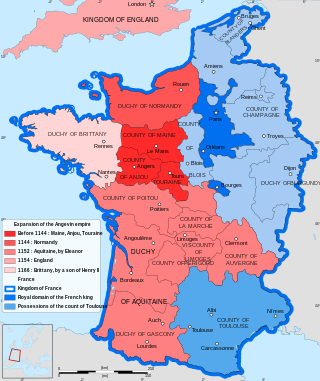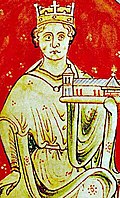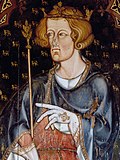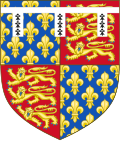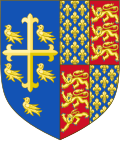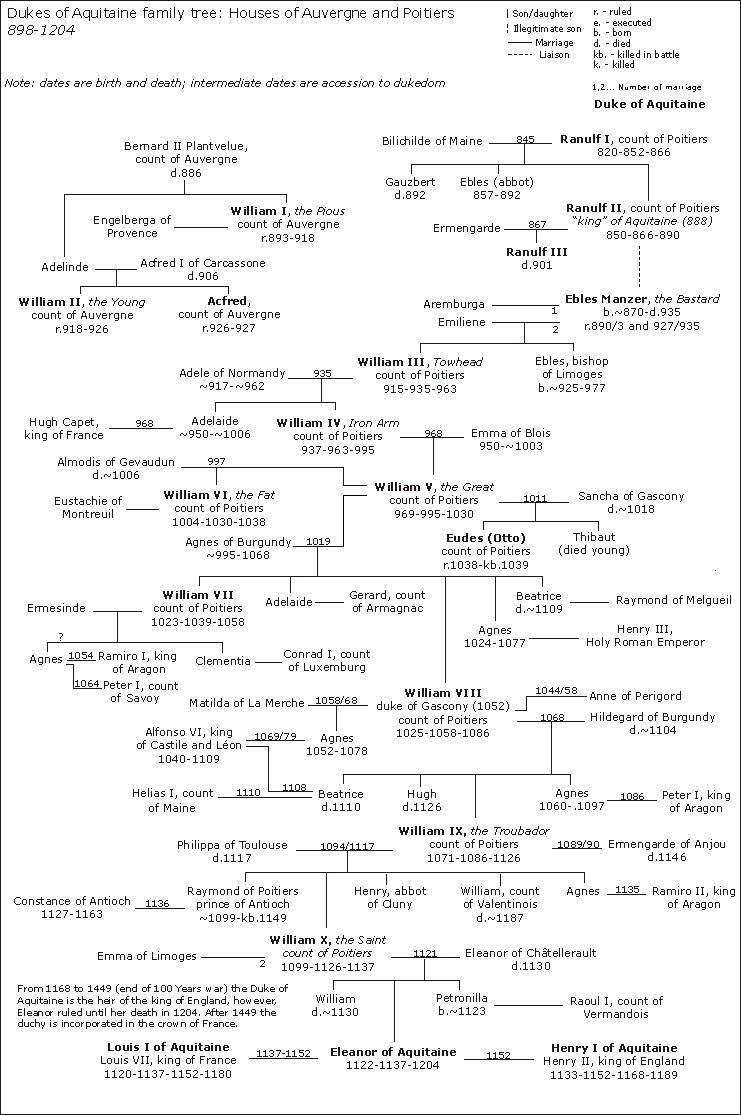Top Qs
Timeline
Chat
Perspective
Duke of Aquitaine
Ruler of the ancient region of Aquitaine From Wikipedia, the free encyclopedia
Remove ads
The duke of Aquitaine (Occitan: Duc d'Aquitània, French: Duc d'Aquitaine, IPA: [dyk dakitɛn]) was the ruler of the medieval region of Aquitaine (not to be confused with modern-day Aquitaine) under the supremacy of Frankish, English, and later French kings.
This article possibly contains original research. (May 2023) |
This article needs additional citations for verification. (May 2023) |

As successor states of the Visigothic Kingdom (418–721), Aquitania (Aquitaine) and Languedoc (Toulouse) inherited both Visigothic law and Roman Law, which together allowed women more rights than their contemporaries would enjoy until the 20th century. Particularly under the Liber Judiciorum as codified in 642/643 and expanded by the Code of Recceswinth in 653, women could inherit land and titles and manage their holdings independently from their husbands or male relations, dispose of their property in legal wills if they had no heirs, represent themselves and bear witness in court from the age of 14, and arrange for their own marriages after the age of 20.[1] As a consequence, male-preference primogeniture was the practiced succession law for the nobility.
Remove ads
Coronation
The Merovingian kings and dukes of Aquitaine used Toulouse as their capital.[citation needed] The Carolingian kings used different capitals situated farther north. In 765, Pepin the Short bestowed the captured golden banner of the Aquitainian duke, Waiffre, on the Abbey of Saint Martial in Limoges.[citation needed] Pepin I of Aquitaine was buried in Poitiers. Charles the Child was crowned at Limoges and buried at Bourges.[citation needed] When Aquitaine briefly asserted its independence after the death of Charles the Fat, it was Ranulf II of Poitou who took the royal title.[citation needed] In the late tenth century, Louis the Indolent was crowned at Brioude.[citation needed]
The Aquitainian ducal coronation procedure is preserved in a late twelfth-century ordo (formula) from Saint-Étienne in Limoges, based on an earlier Romano-German ordo. In the early thirteenth century a commentary was added to this ordo, which emphasised Limoges as the capital of Aquitaine. The ordo indicated that the duke received a silk mantle, coronet, banner, sword, spurs, and the ring of Saint Valerie.[citation needed]
Remove ads
Visigothic dukes
Dukes of Aquitaine under Frankish kings
Merovingian kings are in boldface.
- Chram (555–560)
- Desiderius (583–587, jointly with Bladast)
- Bladast (583–587, jointly with Desiderius)
- Gundoald (584/585)
- Austrovald (587–589)
- Sereus (589–592)
- Chlothar II (592–629)
- Charibert II (629–632)
- Chilperic (632)
- Boggis (632–660)
- Felix (660–670)
- Lupus I (670–676)
- Odo the Great (688–735), his reign commenced perhaps as late as 692, 700, or 715, unclear parentage
- Hunald I (735–745), son of Odo the Great, abdicated to a monastery
- Waifer (745–768), son of Hunald I
- Hunald II (768–769), probably son of Waifer
- Lupo II (768–781), Duke of Gascony, opposed Charlemagne's rule and Hunald's relatives.
Direct rule of Carolingian kings
Restored dukes of Aquitaine under Frankish kings
Summarize
Perspective
The Carolingian kings again appointed Dukes of Aquitaine, first in 852, and again since 866.[citation needed] Later, this duchy was also called Guyenne.[citation needed]
House of Poitiers (Ramnulfids)
House of Auvergne
The following were also Count of Auvergne.
House of Poitiers (Ramnulfids) restored (927–932)
- Ebalus the Bastard (also called Manzer) (927–932)), illegitimate son of Ranulph II and distant cousin of Acfred, also Count of Poitiers and Auvergne.
House of Rouergue
- Raymond I Pons (932–936)
- Raymond II (936–955)
House of Capet
- Hugh the Great (955–962)
House of Poitiers (Ramnulfids) restored (962–1152)
- William III Towhead (962–963), son of Ebalus, also Count of Poitiers and Auvergne.
- William IV Iron Arm (963–995), son of William III, also Count of Poitiers.
- William V the Great (995–1030), son of William IV, also Count of Poitiers.
- William VI the Fat (1030–1038), first son of William V, also Count of Poitiers.
- Odo (1038–1039), second son of William V, also Count of Poitiers and Duke of Gascony.
- William VII the Eagle (1039–1058), third son of William V, also Count of Poitiers.
- William VIII (1058–1086), fourth son of William V, also Count of Poitiers and Duke of Gascony.
- William IX the Troubadour (or the Younger) (1086–1127), son of William VIII, also Count of Poitiers and Duke of Gascony.
- William X the Saint (1127–1137), son of William IX, also Count of Poitiers and Duke of Gascony.
- Eleanor of Aquitaine (1137–1204), daughter of William X, also Countess of Poitiers and Duchess of Gascony, married the kings of France and England in succession.
- Louis the Younger (1137–1152), also King of France, duke in right of his wife.

From 1152, the Duchy of Aquitaine was held by the Plantagenets, who also ruled England as independent monarchs and held other territories in France by separate inheritance (see Plantagenet Empire). The Plantagenets were often more powerful than the kings of France, and their reluctance to do homage to the kings of France for their lands in France was one of the major sources of conflict in medieval Western Europe.
House of Plantagenet
Remove ads
Plantagenet rulers of Aquitaine
Summarize
Perspective
In 1337, King Philip VI of France reclaimed the fief of Aquitaine from Edward III, King of England.[11] Edward in turn claimed the title of King of France, by right of his descent from his maternal grandfather King Philip IV of France. This triggered the Hundred Years' War, in which both the Plantagenets and the House of Valois claimed supremacy over Aquitaine.
Lord of Aquitaine (1360–1369)
In 1360, both sides signed the Treaty of Brétigny, in which Edward renounced the French crown but remained sovereign Lord of Aquitaine (rather than merely duke).[12] However, when the treaty was broken in 1369, both these English claims and the war resumed.
Prince of Aquitaine and Gascony (1362–1372)
In 1362, King Edward III, as Lord of Aquitaine, made his eldest son Edward, Prince of Wales, Prince of Aquitaine and Gascony.[13]
On 6 October 1372, Prince Edward (who had returned to England the previous year) resigned the Principality of Aquitaine and Gascony, stating that the revenues he earned from Aquitaine were no longer sufficient to cover his expenses.[14] Thus, King Edward III, his father, resumed his title as Duke of Aquitaine.
Duke of Aquitaine (1372–1453)
Remove ads
Valois and Bourbon dukes of Aquitaine
The Valois kings of France, claiming supremacy over Aquitaine, granted the title of duke to their heirs, the Dauphins.
- John II (1345–1350), son of Philip VI of France, acceded in 1350 as King of France.
- Charles, Dauphin of France, Duke of Guyenne (1392?–1401), son of Charles VI of France, Dauphin.
- Louis (1401–1415), son of Charles VI of France, Dauphin.
With the end of the Hundred Years' War, Aquitaine returned under direct rule of the king of France and remained in the possession of the king. Only occasionally was the duchy or the title of duke granted to another member of the dynasty.
- Charles, Duc de Berry (1469–1472), son of Charles VII of France.
- Xavier (1753–1754), second son of Louis, Dauphin of France.
The Infante Jaime, Duke of Segovia, son of Alfonso XIII of Spain, was one of the Legitimist pretenders to the French throne. In 1972, he conferred the hereditary title of Duke of Aquitaine on his son, Gonzalo, who died in 2000 without legitimate progeny.[18]
Remove ads
Family tree
See also
Notes
- Count of Poitiers from 835, Duke of Aquitaine from 852
- Son of Ranulf I, also Count of Poitiers, called himself King of Aquitaine from 888 until his death.
- nephew of William I
- brother of William II
- Duke of Aquitaine by right of his wife, Eleanor of Aquitaine.
- Henry Curmantle was crowned as King Henry II of England on 19 December 1154 with his queen, Eleanor of Aquitaine.
- Henry II was buried at Fontevraud Abbey.
- Ruled alongside his mother, Eleanor of Aquitaine, who acted as regent for the Duchy while he was on crusade – a position he resumed on his return to Europe.
- Richard was first appointed Duke of Aquitaine in 1172 by his father, Henry II of England, the previous Duke.[3][4] Richard would later be crowned King of England on 3 September 1189, several months after his father's death on 6 July.
- Richard I was buried at Rouen Cathedral. His body currently lies at Fontevraud Abbey.
- Ruled alongside his mother, Eleanor of Aquitaine, until her death in 1204; afterwards, sole duke of Aquitaine.
- John was crowned on 27 May 1199.
- John was buried at Worcester Cathedral.
- Henry III was crowned on 28 October 1216.
- Edward I was crowned on 19 August 1274 with Queen Eleanor.
- Edward II was crowned on 25 February 1308 with Queen Isabella.
- Edward II continued as King of England until 20 January 1325
- The date of Edward II's death is disputed by historian Ian Mortimer, who argues that he may not have been murdered, but held imprisoned in Europe for several more years.[8]
- Edward of Windsor, while still heir to the throne, was appointed Duke of Aquitaine by his father, King Edward II of England.[10] After the king was overthrown by the Parliament of 1327, Edward III was proclaimed the new King of England on 25 January 1327, and crowned on 1 February 1327.
- On 24 May 1337, Philip VI of France confiscated the Duchy of Aquitaine from Edward III, beginning the Hundred Years' War.[11] Regardless, Edward III continued to title himself Duke of Aquitaine, and responded by claiming the throne of France for himself. Edward continued to use the titles of King of England and France and Duke of Aquitaine until the Treaty of Brétigny in 1360, when Edward renounced these titles in exchange for recognition as sovereign Lord of Aquitaine.
- Philip VI and John II's position as King of France was disputed by King Edward III of England from 1340 until 1360.
- Richard II was crowned on 16 July 1377.
- In 1390, King Richard II, son of Edward the Black Prince, appointed his uncle John of Gaunt Duke of Aquitaine. This grant expired upon the Duke's death, and the dukedom reverted to the Crown. Regardless, due to Henry IV's seizure of the crown, he still came into possession of the dukedom. [17] [better source needed]
- Also Duke of Lancaster (1362), Earl of Leicester, Earl of Lancaster, Earl of Derby, Baron of Halton (1361). Formerly Earl of Richmond from 1342 until 1372.
- Second tenure
- Henry IV was crowned on 13 October 1399.
- Henry, Prince of Wales to 1413, Henry V of England afterwards
- Henry VI was crowned on 6 November 1429.
- Effectively lost control of Aquitaine after the end of the Hundred Year's War
Remove ads
References
Wikiwand - on
Seamless Wikipedia browsing. On steroids.
Remove ads
